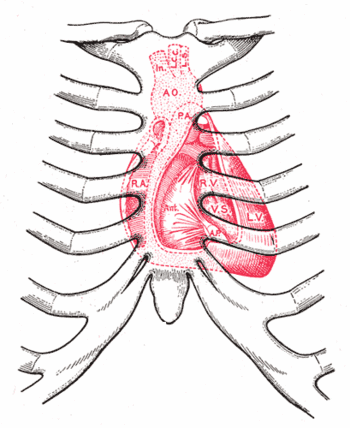Heart sound
In medicine, heart sounds are the "sounds heard over the cardiac region produced by the functioning of the heart. There are four distinct sounds: the first occurs at the beginning of systole and is heard as a "lubb" sound; the second is produced by the closing of the aortic valve and pulmonary valve and is heard as a "dupp" sound; the third is produced by vibrations of the ventricular walls when suddenly distended by the rush of blood from the heart atria; and the fourth is produced by atrial contraction and ventricular filling."[1]
Normal heart sounds
A diagram of the cardiac cycle is available and helps understand the normal heart sounds.[2]
S1
S1, which originates from closure of the mitral and tricuspid valves is normally louder than S2 at the cardiac apex (fifth left intercostal space).[2][3]
The S1 is actually two sounds, closure of mitral (M1) and tricuspid (T1) valves. M1 precedes T1 by 20 to 30 msec. This physiologic splitting is best heard at the lower left sternal border (the tricuspid area). Intervals less than 30 to 40 msec may sound like a single sound.<[4]
S2
S2 is normally louder than S1 at the cardiac base (second left intercostal space).[5] "With quiet respiration, A2 will normally precede P2 by 0.02 to 0.08 second (mean, 0.03 to 0.04 sec) with inspiration."[6] Intervals less than 30 to 40 msec will sound like a single sound.<[4]
The S2 is composed of A2 and P2:
- A2 originates from closure of the aortic valve
- P2 originates from closure of the pulmonic valve, is best heard at the cardiac base (second left intercostal space), and is quieter than A2.
S3
More discussion is available online.[9]
S4
The S4, if present, is best heard at the cardiac apex. More discussion is available online.[10]
Abnormal heart sounds
S1
More discussion is available online.[2]
A loud S1 may be from:
- Increased valve gradient (mitral valve obstruction as in mitral stenosis or atrial myxoma)
- Increased valve flow (left-to-right shunt in PDA, VSD, and high output)
- Shortened diastole (tachycardia)
- Short PR intervals (preexcitation syndrome)
S2
More discussion is available online.[6]
- Fixed split S2 may be from:
- Hemodynamic abnormalities: interatrial communication such as an atrial septal defect
- Paradoxical split S2 may be from
- Conduction abnormalities: left bundle branch block, artificial RV pacing, preexcitation of the RV
- Hemodynamic abnormalities: aortic valve stenosis
- Wide split S2 may be from
- Conduction abnormalities: right bundle branch block, artificial LV pacing, and preexcitation of the LV
- Hemodynamic abnormalities: pulmonary stenosis and pulmonary hypertension
S3
More discussion is available online.[9]
S4
More discussion is available online.[10]
References
- ↑ Anonymous (2024), Heart sound (English). Medical Subject Headings. U.S. National Library of Medicine.
- ↑ 2.0 2.1 2.2 Felner JM (1990). “The First Heart Sound”, Walker HK, Hall WD, Hurst JW: Clinical methods: the history, physical, and laboratory examinations (in English), 3rd. London: Butterworths, 119. LCC RC71 .C63. ISBN 0-409-90077-X. Library of Congress Cite error: Invalid
<ref>tag; name "isbn0-409-90077-X-p119" defined multiple times with different content Cite error: Invalid<ref>tag; name "isbn0-409-90077-X-p119" defined multiple times with different content - ↑ McGee, Steven R. (2007). “The First and Second Heart Sounds”, Evidence-Based Physical Diagnosis, 2nd. Philadelphia: Saunders, 418. ISBN 1-4160-2898-6.
- ↑ 4.0 4.1 Felner JM (1990). “The Second Heart Sound”, Walker HK, Hall WD, Hurst JW: Clinical methods: the history, physical, and laboratory examinations (in English), 3rd. London: Butterworths, 125. LCC RC71 .C63. ISBN 0-409-90077-X. Library of Congress PDF
- ↑ McGee, Steven R. (2007). “Auscultation of the Heart: General Principles”, Evidence-Based Physical Diagnosis, 2nd. Philadelphia: Saunders, 415. ISBN 1-4160-2898-6.
- ↑ 6.0 6.1 Felner JM (1990). “The Second Heart Sound”, Walker HK, Hall WD, Hurst JW: Clinical methods: the history, physical, and laboratory examinations (in English), 3rd. London: Butterworths, 122. LCC RC71 .C63. ISBN 0-409-90077-X. Library of Congress PDF Cite error: Invalid
<ref>tag; name "isbn0-409-90077-X-p122" defined multiple times with different content - ↑ McGee, Steven R. (2007). “The First and Second Heart Sounds”, Evidence-Based Physical Diagnosis, 2nd. Philadelphia: Saunders, 422. ISBN 1-4160-2898-6.
- ↑ 8.0 8.1 Harris A, Sutton G (November 1968). "Second heart sound in normal subjects". British heart journal 30 (6): 739–42. PMID 5718983. PMC 487796. [e] PubMed Central
- ↑ 9.0 9.1 Silverman ME (1990). “The Third Heart Sound”, Walker HK, Hall WD, Hurst JW: Clinical methods: the history, physical, and laboratory examinations (in English), 3rd. London: Butterworths, 126. LCC RC71 .C63. ISBN 0-409-90077-X. Library of Congress PDF
- ↑ 10.0 10.1 Williams ES (1990). “The Fourth Heart Sound”, Walker HK, Hall WD, Hurst JW: Clinical methods: the history, physical, and laboratory examinations (in English), 3rd. London: Butterworths, 129. LCC RC71 .C63. ISBN 0-409-90077-X. Library of Congress PDF
Bibliography
- Drummond Rennie; David Simel (2008). THE RATIONAL CLINICAL EXAMINATION: EVIDENCE-BASED CLINICAL DIAGNOSIS (Jama & Archives Journals). McGraw-Hill Professional. ISBN 0-07-159030-7.
- McGee, Steven R. (2007). Evidence-Based Physical Diagnosis. Philadelphia: Saunders. ISBN 1-4160-2898-6.
- (1990) Walker HK, Hall WD, Hurst JW: Clinical methods: the history, physical, and laboratory examinations (in English), 3rd. London: Butterworths. LCC RC71 .C63. ISBN 0-409-90077-X. Library of Congress
